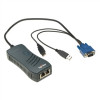Lantronix Spider KVM Over IP Switch SpiderView User Guide - Page 4
Introduction, Installation, Finding, Configuring, and Organizing Spider Devices, Configuration
 |
View all Lantronix Spider KVM Over IP Switch manuals
Add to My Manuals
Save this manual to your list of manuals |
Page 4 highlights
Introduction The Lantronix® Spider™ View product is a Windows®-based application designed to facilitate the management of multiple Lantronix® Spider™ devices. From your PC, you can auto-locate Spider devices (within the local subnet), give Spider devices user-friendly names, organize Spider devices into groups, manage Spider settings, and launch Remote Console (KVM Console) windows. In addition to individual Remote Console windows, Spider View also provides an Observation Window where several Spider Remote Console windows can be viewed, allowing easy interaction with multiple remotely managed target systems. The terms "Remote Console" and "KVM" Console are synonymous and used interchangeably throughout the user guide and Spider View application. Installation Spider View is a standalone application requiring installation on the client system. Spider View is supported on systems running Windows® 2000, XP, Vista, or Windows® 2003 Server. The system requirements are: 500MHz CPU, 64MB available RAM, 10MB free disk space. 1. From the product CD, select the Spider View button.. 2. Follow the prompts during installation. 3. When prompted, accept the license agreement. 4. Select the folder for the software installation location and the shortcuts required. 5. To run Spider View, double-click the Spider View icon or select the utility from the Start Menu. Finding, Configuring, and Organizing Spider Devices Spider View automatically finds all Spider devices residing on the same subnet as the client system. Other Spider devices may be manually added via their IP address. 1. Select ConfigurationFind New Devices or the icon. Newly found Spider devices are listed under the Unconfigured Devices group, listed by their MAC addresses. 2. Right-click on a Spider and select Change Connection Settings. The Device Configuration window displays. Spider™ View User Guide 4












